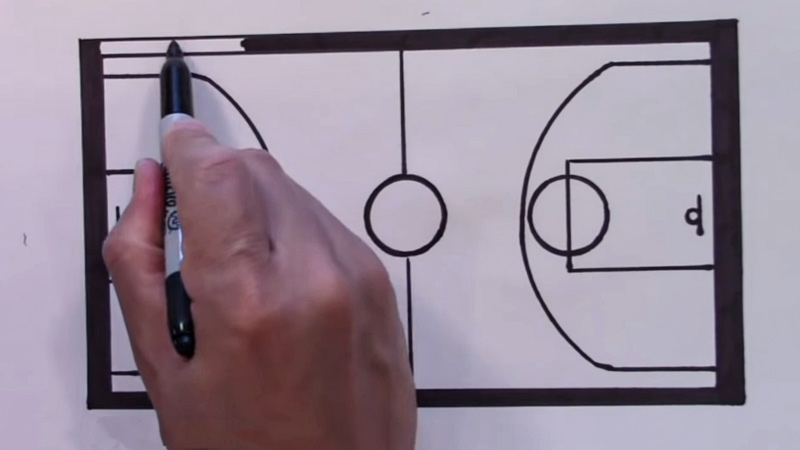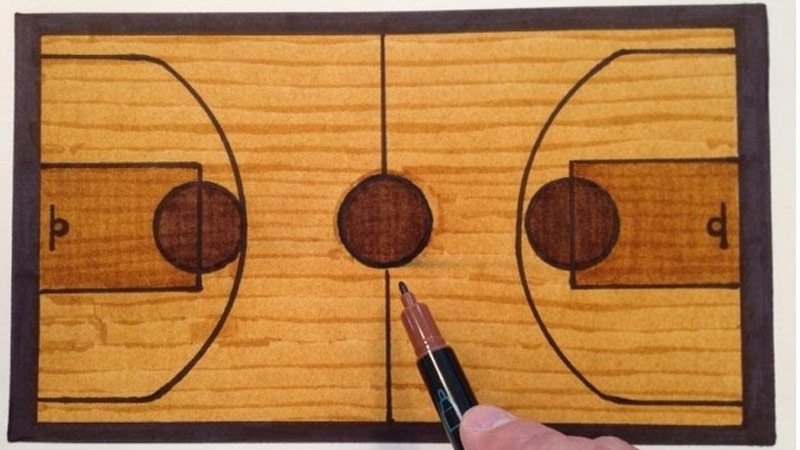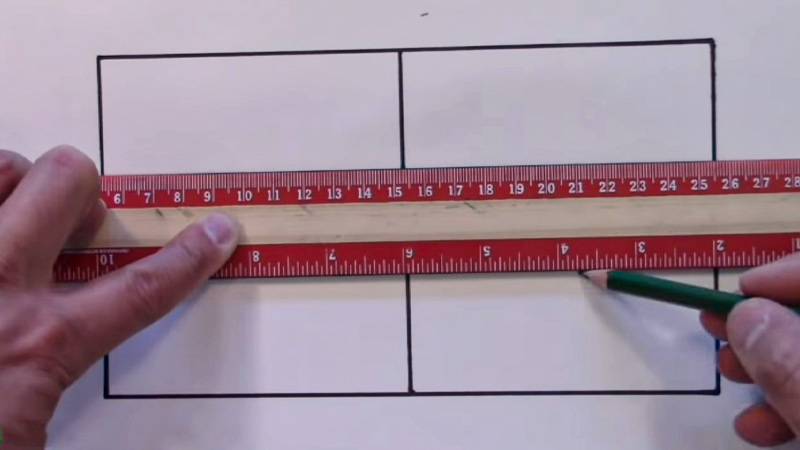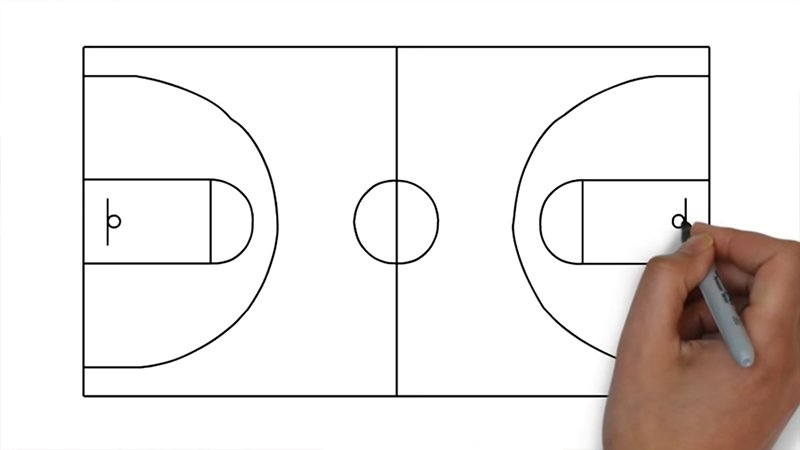Drawing a basketball court can be a useful skill for various purposes, such as creating diagrams for coaching, organizing recreational games, or simply satisfying your creative side.
Whether you’re a coach, a player, or a basketball enthusiast, knowing how to draw a basketball court accurately can enhance your understanding of the game and facilitate effective communication.
In this article, we will provide step-by-step instructions on drawing a basketball court, highlight the materials needed, and share some tips to ensure accuracy and clarity in your drawing. So, let’s get started.
When do You Need to Draw a Basketball Court?
Drawing a basketball court becomes necessary in various situations where visual representation is essential. Here are some common scenarios where drawing a basketball court is beneficial:
Coaching and Instruction
Coaches often use court diagrams to explain plays, offensive and defensive strategies, and player positions. By visually representing the court, coaches can effectively communicate their ideas and strategies to the team.
Game Planning
Organizers of recreational basketball leagues, tournaments, or pick-up games may need to draw courts to plan game schedules and allocate court space.
This helps in organizing multiple games simultaneously and ensuring smooth gameplay.
Player Development
Drawing a basketball court can aid in player development by analyzing and improving individual and team performance.
Coaches can identify areas of improvement, positional responsibilities, and offensive and defensive schemes using court diagrams.
Art and Graphic Design
Basketball enthusiasts who enjoy creating basketball-themed art or designing sports-related graphics may find drawing a basketball court to be a fulfilling creative endeavor.
It allows them to showcase their passion for the game and capture its essence visually.
Things You Will Need to Draw a Basketball Court

To draw a basketball court, gather the following materials. Check them out below.
Large Paper or Poster Board
Choose a size that allows you to accurately depict the court dimensions. A larger surface provides ample space for detailing.
Pencil
Use a sharpened pencil to create precise lines and markings. It allows you to make adjustments and corrections easily.
Ruler or Straight Edge
A ruler or straight edge is essential for drawing straight lines for the court boundaries, sidelines, key, and other markings. It helps maintain accuracy and consistency in your drawing.
Protractor
A protractor comes in handy for drawing the arcs of the three-point line and the center circle. It ensures the proper curvature of these elements.
Eraser
Keep an eraser nearby to erase mistakes or make adjustments during the drawing process. It allows you to maintain the cleanliness and accuracy of your drawing.
By gathering these materials, you’ll have everything you need to create a detailed and accurate representation of a basketball court.
How to Draw a Basketball Court: Step-by-Step Instructions

Follow these detailed step-by-step instructions to draw a basketball court accurately:
Step 1: Determine the Dimensions
Start by understanding the standard dimensions of a basketball court. In the NBA and NCAA, the court is 94 feet long and 50 feet wide. However, you can adjust the dimensions based on the level of play or the available space.
Take into account any modifications or variations required for your specific purposes, such as recreational leagues or smaller courts.
Step 2: Draw the Baseline
Using a ruler, draw a straight line representing the baseline of the court. Measure and mark the appropriate length based on the chosen dimensions.
Ensure that the line is straight and accurately reflects the specified length. This forms the foundation of the court.
Step 3: Draw the Sidelines
Draw two straight lines perpendicular to the baseline, representing the sidelines of the court. These lines should be parallel to each other and measure the correct length.
Use a ruler to maintain straightness and precision. The sidelines define the width of the court.
Step 4: Add the Key or Painted Area
Measure and mark the dimensions of the key, also known as the painted area, on the court.
This rectangular area with rounded corners is located at a specific distance from the baseline. Draw the rectangle accurately, ensuring the corners are rounded smoothly.
The key is where players position themselves during free throws and certain offensive plays.
Step 5: Include the Free-Throw Line
Measure and mark the length of the free-throw line from the baseline. Draw a straight line parallel to the baseline at the designated distance.
Use a ruler to maintain the accuracy and straightness of the line. The free-throw line is where players shoot free throws from.
Step 6: Draw the Three-Point Line
Using a protractor, mark the center of the court and draw a circle with the correct radius. This circle represents the center circle, where the tip-off takes place. From the top of the key, draw two lines extending outwards to form the three-point arc.
These lines should meet the perimeter of the court at the appropriate distance. The three-point line determines the area from which shots count for three points.
Step 7: Add Other Markings
To complete your basketball court drawing, include additional markings such as the center circle, half-court line, and any specific markings required for your court diagram.
Pay attention to the dimensions and placements of these markings, ensuring they are accurately represented on your drawing. These markings provide additional reference points and aid in understanding the court layout.
By following these step-by-step instructions and using the appropriate tools, you can draw a basketball court accurately.
Remember to measure carefully, use straight edges for straight lines, and pay attention to the specific dimensions and markings.
Things to be Careful of When Drawing a Basketball Court
When drawing a basketball court, it’s important to pay attention to detail and ensure accuracy. Here are some key points to consider:
Measure accurately

To create an accurate representation of a basketball court, use a ruler or measuring tape to ensure precise measurements for the court’s dimensions and markings. Double-check your measurements to avoid any errors.
Straight lines
Utilize a straight edge or ruler to draw straight lines for the court boundaries, including the baseline and sidelines. Straight lines contribute to the overall neatness and professionalism of your drawing.
Consistency
Maintain consistency in the size and proportion of the court elements. This includes the key, three-point line, center circle, and other markings.
Refer to official court dimensions or reliable reference images to ensure your drawing aligns with the standard measurements.
Check for accuracy
Regularly review your drawing against official court dimensions or reference images to ensure that your proportions, markings, and measurements are accurate.
This step is crucial to avoid any discrepancies or inaccuracies in your final drawing.
Erase mistakes carefully
Mistakes happen, and when they do, use an eraser gently to correct them. Be cautious not to damage the paper or leave noticeable marks.
Take your time to erase any errors and make necessary adjustments to maintain the overall quality of your basketball court drawing.
FAQs
Can I draw a basketball court on any size of paper?
It’s best to use a large paper or poster board that allows you to draw the court dimensions accurately. However, you can scale down the dimensions if needed.
Are there different court sizes for different levels of basketball?
Yes, the dimensions of a basketball court can vary based on the level of play. The NBA and NCAA have standard court dimensions, but other leagues or organizations may have slight variations.
Can I use a digital tool to draw a basketball court?
Yes, there are various digital drawing tools and software available that allow you to create accurate basketball court diagrams. These tools offer more flexibility and options for customization.
Do I need to include specific markings, such as the restricted area or coaches’ box?
The specific markings you include in your basketball court drawing depend on your intended use. If you are creating a diagram for coaching or instructional purposes, including additional markings can be beneficial.
Can I add colors and details to my basketball court drawing?
Absolutely! Adding colors and details can enhance the visual appeal of your basketball court drawing. Feel free to get creative and personalize your drawing based on your preferences.
Bottom Line
Drawing a basketball court requires attention to detail and accuracy to ensure an informative and visually appealing representation.
By following the step-by-step instructions, using the necessary materials, and considering the tips provided, you can create a well-drawn basketball court that serves its intended purpose.
Whether you’re a coach, player, or fan, being able to draw a basketball court can be a valuable skill that enhances your understanding and enjoyment of the game.
So grab your materials and start drawing your very own basketball court today! Good luck.







